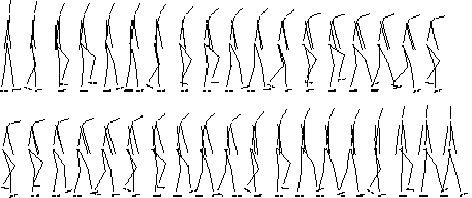 |
 |
 |
 |
 |
 |
 |
 |
 |
 |
 |
 |
 |
 |
 |
 |
 |
 |
 |
 |
 |
 |
 |
 |
 |
 |
 |
 |
 |
 |
 |
 |
 |
 |
 |
 |
|
 94 94

Figure 5.19 shows the composite perturbation for the human
|
 |
|
used to avoid overhead obstacles.
|
 |
|
model used with the bent-over perturbation.
|
 |
|
transition
 info info
|

0
0
0
0
0
0
|
|
 |
|
DOF:

state
|
|
1
5
5
5
5
5
5
|
 2 2
40
40
40
40
40
40
|
3:0 3:1 3:1 3:2 3:2
|
 4 4
20
20
20
20
20
20
|
5:0 5:1 5:1 6:0 6:0 6:1 6:1 6:2 6:2
|
 7 7
20
20
20
20
20
20
|
8:0 8:1 8:1
|
 9 9
-52
-52
-52
-42
-33
-33
|
10
-5
-5
-5
-5
-5
-2
|
 11 11
-42
-33
-33
-52
-52
-52
|
12
-5
-5
 2 2
-5
-5
-5
|
13
15
15
15
15
15
15
|
 |
|
S1
S2
S3
S4
S5
S6
|
|
0
0
0
0
0
0
|
-20
-20
-20
-20
-20
-20
|
0
0
0
0
0
0
|
|
0
0
0
0
0
0
|
0
0
0
0
0
0
|
0
0
0
0
0
0
|
-20
-20
-20
-20
-20
-20
|
0
0
0
0
0
0
|
|
0
0
0
0
0
0
|
0
0
0
0
0
0
|
 |
|
Figure 5.19 - Composite bent-knee, bent-over and bent-neck perturbation
|
 |
|
Figure 5.20 shows the transitions to and from "ducking". shows the transitions to and from "ducking".
|
Note
|
that
|
while
|
the
|
bent-knee
|
 |
|
perturbation was originally designed for a slower rate walk which uses speed control, it also
works well when applied to a different basic walk (bent-over) without speed control.
|
 |
|

|
 |
|
(a)

(b)
|
 |
|
Figure 5.20 - Ducking
 (a) straight to ducking transition (a) straight to ducking transition
 (b) ducking to straight transition (b) ducking to straight transition
|
 |
|
While the ducking perturbation is demonstrated here in an open loop configuration, one can
imagine using feedback to provide the biped with the ability to automatically duck under obstacles
in its path.
|
 |

 1
2
3
4
5
6
7
8
9
10
11
12
13
14
15
16
17
18
19
20
21
22
23
24
25
26
27
28
29
30
31
32
33
34
35
36
37
38
39
40
41
42
43
44
45
46
47
48
49
50
51
52
53
54
55
56
57
58
59
60
61
62
63
64
65
66
67
68
69
70
71
72
73
74
75
76
77
78
79
80
81
82
83
84
85
86
87
88
89
90
91
92
93
94
95
96
97
98
99
100
101
102
103
104
105
106
107
108
109
110
111
112
113
114
115
116
117
118
119
120
121
122
123
124
125
126
127
128
129
130
131
132
133
134
135
1
2
3
4
5
6
7
8
9
10
11
12
13
14
15
16
17
18
19
20
21
22
23
24
25
26
27
28
29
30
31
32
33
34
35
36
37
38
39
40
41
42
43
44
45
46
47
48
49
50
51
52
53
54
55
56
57
58
59
60
61
62
63
64
65
66
67
68
69
70
71
72
73
74
75
76
77
78
79
80
81
82
83
84
85
86
87
88
89
90
91
92
93
94
95
96
97
98
99
100
101
102
103
104
105
106
107
108
109
110
111
112
113
114
115
116
117
118
119
120
121
122
123
124
125
126
127
128
129
130
131
132
133
134
135

